Melissa Stewart's Blog
November 18, 2025
Where I'll Be at NCTE!
November 10, 2025
It’s Time for the Sibert Smackdown!
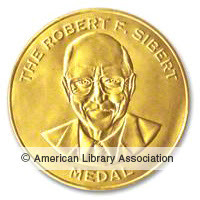 The Sibert Smackdown is an activity intended to build enthusiasm forthe
Robert F. Sibert Informational Book Medal
, which is given each year as part ofthe American Library Association’s annual
Youth Media Awards
. It focuses onpicture books because they’re more manageable to read in a school setting.
The Sibert Smackdown is an activity intended to build enthusiasm forthe
Robert F. Sibert Informational Book Medal
, which is given each year as part ofthe American Library Association’s annual
Youth Media Awards
. It focuses onpicture books because they’re more manageable to read in a school setting.Here’s how itworks. Students in grades 3-8 read the nonfiction picture books onyour class’s Mock Sibert list. You can use the book’s I’ve suggested below, select titles from Anderson'sBookshop list (Coming Soon!), or featureyour own favorite nonfiction titles from 2025. My list includes titles that have strong kid appeal, willpromote good discussions, and can be used as mentor texts in writingworkshop. They reinforce the research techniques and craft moves included inmost State ELA standards.
 Alberto Salas Plays Paka Paka con la Papa:
Jointhe Quest with Peru’s Famed Scientist and Potato Expert by Sara Andrea Fajardo and Juana Martinez-Neal
Alberto Salas Plays Paka Paka con la Papa:
Jointhe Quest with Peru’s Famed Scientist and Potato Expert by Sara Andrea Fajardo and Juana Martinez-Neal
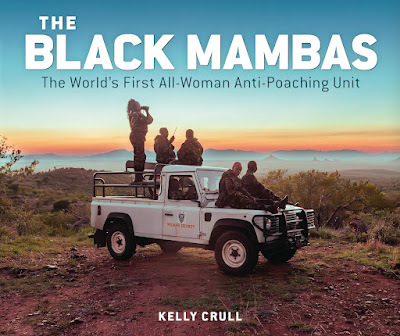 Black Mambas: TheWorld’s First All-Woman Anti-Poaching Unit by Kelly Crull
Black Mambas: TheWorld’s First All-Woman Anti-Poaching Unit by Kelly Crull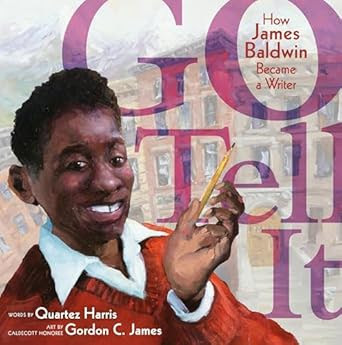 Go Tell It: How James Baldwin Became a Writer by Quartez Harris and GordonC. James
Go Tell It: How James Baldwin Became a Writer by Quartez Harris and GordonC. James

The History of We by Nikkolas Smith
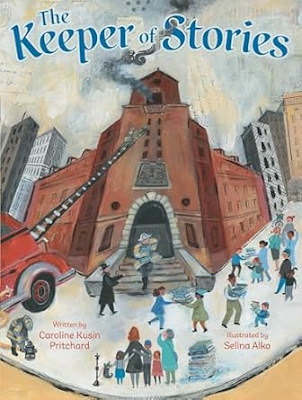 The Keeper of Stories by Caroline Kusin Pritchard and Selina Alko
The Keeper of Stories by Caroline Kusin Pritchard and Selina Alko
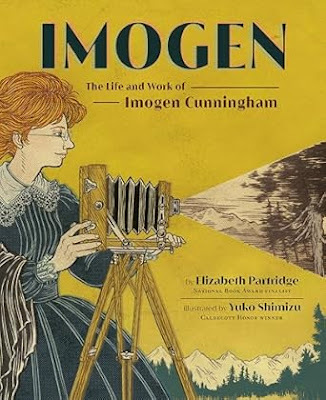 Imogen: The Life and Work of Imogen Cummingham by Elizabeth Partridge and Yuko Shimizu
Imogen: The Life and Work of Imogen Cummingham by Elizabeth Partridge and Yuko Shimizu
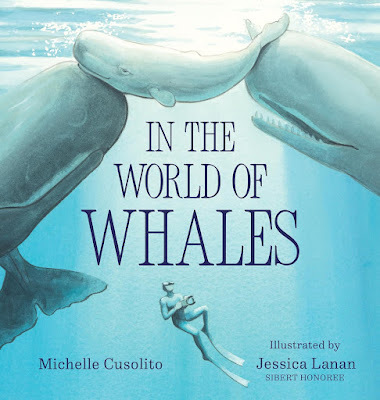 In the World of Whales by Michelle Cusolito and Jessica Lanan
In the World of Whales by Michelle Cusolito and Jessica Lanan
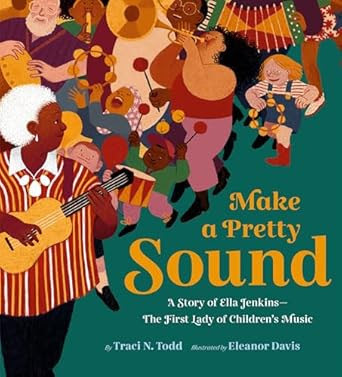 Make a Pretty Sound: A Story of Ella Jenkins—the First Ladyof Music byTraci N. Todd and Eleanor Davis
Make a Pretty Sound: A Story of Ella Jenkins—the First Ladyof Music byTraci N. Todd and Eleanor Davis
 Some of Us: A Story of Citizenship and the United States by Rajani Larocca and Huy Voun Lee
Some of Us: A Story of Citizenship and the United States by Rajani Larocca and Huy Voun Lee
 Toes, Teeth, and Tentacles: A Curious Counting Book bySteve Jenkins and Robin Page
Toes, Teeth, and Tentacles: A Curious Counting Book bySteve Jenkins and Robin Page
 Tomatoes in Trial: The Fruit Vs. Vegetable Showdown by Lindsay H. Metcalf and Edwin Fotheringham
Tomatoes in Trial: The Fruit Vs. Vegetable Showdown by Lindsay H. Metcalf and Edwin Fotheringham
 Zero: The Number that Almost Wasn't by Sarah Albee and Chris Hsu
Zero: The Number that Almost Wasn't by Sarah Albee and Chris HsuWillsome of these books be named on Monday, January 26, 2026, when the Sibert Medal committee announces its winner and honortitles at the ALA Youth Media Awards ceremony? Who knows, but I dohave a pretty good track record.
Afterreading your Mock Sibert titles, students choose their two favoritesand use this worksheet, whichyou can download from my website, to evaluate and compare the books beforethey vote. The worksheet features a kid-friendly version of the criteria usedby the real Sibert committee.
I also suggest using the guidelines developed by former Sibertjudge Melody Allen. They are available here, here, and here.
And I’d recommend reading some of thefollowing posts in which educators describe their past experiences with theSibert Smackdown, including how they
modified or enhanced it. It's soimportant to create learningexperiences that are perfect for your particular students.
The Lowdown on OurSmackdown by Galiah Morgenstern
The Lowdown on OurSmackdown by Mandy Robek
The Low Down on OurSmackdown by Patti Francis
The Low Down on OurSmackdown by Kate Narita
TheLow Down on Our Smackdown by Meredith Inkeles
Sibert Book Club Shinesa Light on Nonfiction by Jessica Fries-Gaither
The Lowdown on theSmackdown by Renae Nichols
I’d loveto hear how your students are progressing, and so would other participatingteachers and librarians. Please tag me on Facebook, Instagram, or Bluesky toshare what you’re doing.
HappyReading!
November 4, 2025
The Joy of Onomatopoeia!

One of thecraft elements that affects how we respond to a book is voice. Is it goofy or sassy?Is it calm and cozy? Or does it fall somewhere in the middle of the lively-to-lyrical voicecontinuum? Writers choose a voice based on their topic and their purpose forwriting.
 My newestbook, From Bam! to Burp! A CarbonAtom’s Never-ending Journey Through Space and Time and YOU, illustrated by Marta Álvarez Miguéns, has alively, playful voice that I hope kids will love.
My newestbook, From Bam! to Burp! A CarbonAtom’s Never-ending Journey Through Space and Time and YOU, illustrated by Marta Álvarez Miguéns, has alively, playful voice that I hope kids will love.A straightforward book about the carbon cycle could be a bit dull, but Iwanted my book to delight readers as well as inform them, so I chose anapproach that could achieve that. Following a carbon atom through time allowedme to highlight all the wonderful creatures and objects it could be part of—fromvolcanoes and dinosaurs to pumpkins and butterflies and, yes, even toilet paper.
So the potential for fun was there, but only if I crafted text to supportthe “personality” I had in mind. And that’s where voice comes in.
According to uber-talented author Linda Sue Park:
voice =word choice + rhythm
rhythm =punctuation + sentence length
I lovethis brilliant explanation because it makes a craft move that often seemsmysterious and elusive instantly manageable. All three of these textcharacteristics are easy to control and vary and play around with.
Today, I’mgoing to focus on how word choice allows writers to exploit different languagedevices, such as alliteration, vivid verbs, and especially onomatopoeia, to infusetext with the voice they have in mind.
As I waswriting From Bam! to Burp!, I looked for opportunities to includefun words. And that began with the title, which features onomatopoeiaplus alliteration. Those two words (which are also vivid verbs) are pulled fromthe book’s main text. One marks the beginning of the carbon atom’s journey, andthe other is at the end.

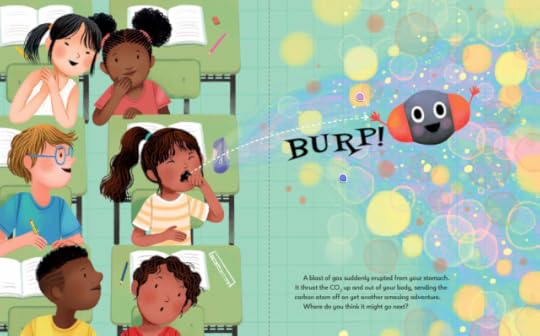
In between,I use onomatopoeia as a repetitive device that moves the story forward. It connects differentadventures along the carbon atom’s journey and fuels pages turns.

My hope is that, during read alouds, kids will anticipate these fun exclamations and think of them as mini-rewards for staying engaged.
This isthe first book I’ve written that onomatopoeia as a key text element, but I hopeit’s not the last because they’re just as much fun to write as they are to read.
October 28, 2025
Happy Book Birthday!
 Yesterday, my newest book From Bam toBurp!: A Carbon Atom’s Never-ending Journey Through Space and Time and YOU,illustrated by Marta Álvarez Miguéns, officially entered the world. I’mgrateful to the Junior Library Guild for naming in a Gold Star Selection, and I’mdelighted that it’s
received some fantasticreviews
.
Yesterday, my newest book From Bam toBurp!: A Carbon Atom’s Never-ending Journey Through Space and Time and YOU,illustrated by Marta Álvarez Miguéns, officially entered the world. I’mgrateful to the Junior Library Guild for naming in a Gold Star Selection, and I’mdelighted that it’s
received some fantasticreviews
.The story behind this book traces all the way backto 2016.
During a school visit in Connecticut, I mentionedthat the atoms inside us today could have been inside a dinosaur that lived 150million years ago on the other side of the world. A hand shot up. It belongedto a curious third grader brimming with questions.
Where had the atom come from?
How did it end up in us?
Where else had it been along the way?
I didn’t know the answers to all those fantasticquestions, but I was curious too. So I started researching.
Writing a book that’s scientifically accurate andfun to read is no easy task. My earliest drafts traced a carbon atom’s path allthe way back through time, but it was boring and repetitive. Next, I triedmaking the carbon atom a character who told its story, but that just didn’twork. Words like BAM! and KABOOM! originated in an unsuccessful attempt tocreate a comic.
Thank goodness I saw a presentation in which uber-talentedauthor Candace Fleming recommended choosing moments to highlight and collapsingtime when using a sequence text structure. What a great tip!
Then, after reading an article about Theia, Idecided to flip the book’s sequence and begin in the past. That’s when themanuscript finally came into focus.
I’m grateful that editor Julie Bliven saw themanuscript’s potential and worked with me thought several revisions to make thebook the best it could be.
From Bam to Burp! connects tothe elementary science curriculum in lots of ways—from atoms and molecules andhow objects interact in space to the carbon cycle and the link between fossilsfuels and climate change. The book has a hearty helping of backmatter to helpeducators make these connections.
To make the book even more useful in the classroom,I’ve created a Read Aloud Guide that invitesstudents to think about how the book was crafted and how authors andillustrators work together as they create a book.
If you have suggestions foradditional educational materials, please let me know.October 21, 2025
A Special Offer for Massachusetts Schools
 As a child growing up in a small western Massachusetts town, I never experienced the excitement of an author visit. I had no idea that real, living people create books.
As a child growing up in a small western Massachusetts town, I never experienced the excitement of an author visit. I had no idea that real, living people create books.To this day, I’m the only author who has visited my hometown elementary school, and that’s not unusual. Many students in Massachusetts have never had the opportunity to meet an author.
Research shows that author visits have the power to:
Nurture a love for readingEnhance literacy skillsFoster creativity and cultural understandingCreate a vibrant and immersive literary environmentBuild career aspirations.That’s why I’m launching a campaign to visit an elementary school in every town in my beloved home state, with a particular focus on western and central Massachusetts as well as Cape Cod.
Since I began visiting schools in 2003, I’ve offered programs at 89 schools in 63 Massachusetts towns. In an effort to reach students in the remaining 229 towns, I’ve designed a low cost, easy to plan, whole-school author event for Meet the Mini-mammals: A Night at the Natural History Museum, illustrated by Caldecott Honoree Brian Lies.
Starting in March 2025, I will charge $500 per school and visit two schools in neighboring towns per day, for a total of $1000. That’s half my normal daily fee.
Here’s a description of the program:
Where Facts and Fiction Meet
Grade K‑5, 45 minutes, no limit to size of audience
This whole-school program begins with a fun, interactive read aloud of Meet the Mini-mammals: A Night at the Natural History Museum, illustrated by Caldecott Honoree Brian Lies. Then Melissa shares the creative process of making the book and how her vision for it changed over time. Student volunteers have an opportunity to participate in engaging STEM activities, and there will be time for Q&A at the end
I’m booking presentations now, so contact me now for more information.
October 14, 2025
Where I'll Be at AASL!
October 7, 2025
Nonfiction Picture Books in Fifth Grade, Part 4: Mentor Texts and Revising in the Classroom by Katie McEnaney and Ellen Bunn
 Last January, fifth grade teacher Katie McEnaney (right) and schoollibrarian Ellen Bunn (left) wrote a
post describing a collaborative nonfiction writing unit
they’ve offered for several years at their school.Their article was very popular, so now they’re back with a more detailedexplanation.
Last January, fifth grade teacher Katie McEnaney (right) and schoollibrarian Ellen Bunn (left) wrote a
post describing a collaborative nonfiction writing unit
they’ve offered for several years at their school.Their article was very popular, so now they’re back with a more detailedexplanation.Now they’re back, providing a step-by-step breakdown of activities thattook place in the library and sharing how those activities supported andenhanced the multi-week learning experience. You can scroll down for the lasttwo posts, which describe how students interacted with a broad range of booksas they learned about nonfiction book categories, writing styles, textstructures, and craft moves in the library.
Today’s postexplains how and why students used published nonfiction picture books as mentortexts and to revise and improve their own nonfiction writing. This process canalso be utilized by adults interest in writing nonfiction for children!
Thank you, Katie and Ellen, for providing this additional information.

Why Use Mentor Texts?
A mentor is a person whoguides you in your journey to learning a new job or skill. But you can alsofind mentors in other pieces of writing, not just in other people. A mentortext allows a student to study craft moves used by a published author and trythem out in their own writing. As Melissa and Marlene say in the 5 Kinds of Nonfiction, mentor texts “canalso help students recognize patterns, think by analogy, and engage in bigpicture thinking” (Stewart & Correia, 2021, p. 18). By studying howpublished authors crafted their books, students can make better decisions abouthow to craft their own nonfiction writing.
Findingand Choosing Mentor Texts
One goal of our nonfictionpicture book writing unit was to expose students to a range of picture bookstructures, topics, and levels. Through the use of sorting sets for the fivetypes of nonfiction (Part 2: Investigating Mentor Texts in the Library for Categoryand Writing Style) and analyzing books for specific text structures andvoice (Part 3: Exploring Mentor Texts in the Library for Text Structure andCraft Moves), students have interacted with dozens of nonfiction picturebooks.
Throughout this process, studentswere encouraged to pay attention to books that interest them as potentialmentor texts. Rather than pick a mentor text about a similar topic, students wereencouraged to think about books that match the category and writing style ofbook they’re writing. During our final book sorting lesson in the schoollibrary, students checked out their personally-selected mentor texts, which wekept in a bin in the classroom for the rest of the unit. This made themaccessible as students drafted and later revised their picture books.
HowMentor Texts Can Inspire Students
During the 2023-2024 schoolyear, Katie had a student who wanted to write a narrative nonfiction book aboutgeckos and fell in love with Honeybee: TheBusy Life of Apis mellifera(Fleming, 2020). He studied Honeybee closelyand used a similar format. He also noticed that Fleming’s text kept returningto a central conflict—the main bee character, Apis, wanted to fly. Inspired by thistechnique, the student wrote about a gecko, Gecky, wanting to explore.


Examples of Nonfiction Revision Using Mentor Texts
After writing the initialdrafts of their picture books, the fifth graders had a week to revise based onfeedback from me, guidance from their mentor texts, and peer editing feedbackfrom each other. Below are several examples of specific sentences that studentsrevised based on carefully studying their chosen mentor text.
I love how their writing becamemore precise and engaging as they revised. Having an authentic audience in mind(their second-grade buddies) also helped push students to do their best work.
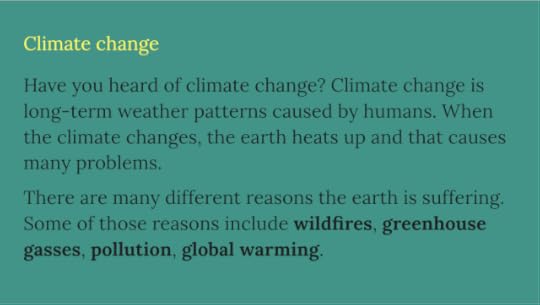
Originalsentence(s): Climate change is long weather patterns caused by humans.
Studentgoal: I wanted to be more specific and more poetic. I made itlonger and more flowy instead of being dull.
Mentortext: Bats (Carney,2010)
Revisedsentence(s): Have you heard of climate change? Climate change islong-term weather patterns caused by humans. When the climate changes, theearth heats up and that causes many problems.

Original sentence(s): The planets are what make up our solar system and we shouldlearn more about them. Most people don’t know that much.
Studentgoal: I wanted to use better language while giving information.
Mentortext: Did You Know?Dinosaurs (St. Fleur, 2020)
Revisedsentence(s): The planets make up our solar system and we should learnmore about them. The sun gives us heat, and we even live on one. We see themoon almost every night and most people don't know a ton about the planets.

Original sentence(s): Another word for mushroom is fungus. A fungus has somethingcalled mycelium underground, which are like their roots.
Studentgoal: I wanted to make the text more appealing to our buddies[second graders].
Mentortext: The Big Book of Blue (Zommer,2018)
Revisedsentence(s): Mushrooms can also be called fungi. Underground, fungi havesomething that looks like roots called mycelia. Two or more fungi can use theirmycelia to communicate by sending chemical or electrical signals to each otherthrough the soil. They usually communicate about food or their surroundings.Using these signals, fungi can “say” around 50 unique “words.”
HowMight You Use Mentor Texts?
Mentor texts are a great toolthat can be applicable to any style and format of student writing. Writingpoetry? Have students analyze a poem with an eye toward poetic devices or formand then have them write their own poems in that style or form. Writingpersuasive pieces? Read aloud published editorials or letters to the editor.Have your students model their own arguments after a certain mentor text. Thepossibilities are endless.
LookingBack, Looking Forward
Thisnonfiction picture book writing project is a labor of love and a work inprogress. This current version is the end result of three years of planning,implementing, reflecting, and revising. Being able to collaborate and alignlibrary time with classroom projects has been an endless source of ideas andinspiration. Kids see that the library is a part of everyday learning and not aonce-a-week silo off by itself.
We are always on the lookoutfor new picture book mentors that effectively model the five types ofnonfiction and that freshen our "one topic/five book" text sets fordisplay in the school library. With the strong foundation provided by 5Kinds of Nonfiction and Nonfiction Writers Dig Deep, we look forwardto next year’s crop of fifth graders coming up with new topics to research andinnovative ways to apply writing style, text structure, and word choice.
As an author, archaeologist,and fifth grade teacher, Katie McEnaney is always on a whirlwind huntfor the perfect artifact to illustrate a point and teach about the past. Herstories have been featured in LittleThoughts Press and the middle grade anthology Clio’s Curious Dash Through Time. When she’s not traveling theworld and geeking out over archaeological sites, you can find her at home inWisconsin with her husband, son, and two very-demanding cats. You can read herand her students’ book reviews at https://www.thelogonauts.com/ .
As a school librarian, EllenBunn enjoys engaging K-8 students in research. She was a committee memberfor the Charlotte Zolotow Book Award (2016, 2017), Sibert Medal Award (2022),and South Asian Book Award (starting 2025). Previously she excavated andpublished about ancient hominin archaeological sites and hunter-gatherers ineastern and southern Africa, before teaching elementary science. Sheparticipates in rural land-use planning in Wisconsin, where she and her husbandhave raised three children, farm animals, and organic vegetables.
Socialmedia links for Katie:
https://www.instagram.com/katie_mcenaney
https://bsky.app/profile/katiemcenaney.bsky.social
Socialmedia links for Ellen:
https://bsky.app/profile/ellenbunn3.bsky.social
https://www.instagram.com/ellenbunn3
September 30, 2025
Writing Nonfiction Picture Books in Fifth Grade, Part 3: Exploring Mentor Texts in the Library for Text Structure and Craft Moves by Ellen Bunn and Katie McEnaney
 Last January, fifth grade teacher Katie McEnaney (right) and schoollibrarian Ellen Bunn (left) wrote a
post describing a collaborative nonfiction writing unit
they’ve offered for several years at their school.Their article was very popular, so now they’re back with a more detailedexplanation.
Last January, fifth grade teacher Katie McEnaney (right) and schoollibrarian Ellen Bunn (left) wrote a
post describing a collaborative nonfiction writing unit
they’ve offered for several years at their school.Their article was very popular, so now they’re back with a more detailedexplanation.Now they’re back, providing a step-by-step breakdown of activities thattook place in the library and sharing how those activities supported andenhanced the multi-week learning experience. You can scroll down for lastweek’s post, which focused on nonfiction book categories and writing styles.
Thank you, Katie and Ellen, for providing this additional information.
Lookingat Nonfiction Books Displayed by Category
During their first librarylesson (scroll down), students sorted themed sets of nonfiction books bywriting style (expository or narrative) and category (active, browsable,traditional, expository literature, and narrative). During this second session,the same books were displayed by categories instead of content.
Because our fifth graders arewriting nonfiction to share with second-grade buddies, books on the traditionalnonfiction table included titles intended for younger readers (front row,below) as well as titles written at a fifth-grade level (back row, below).Including the two levels of books helped students see how simple text, largefonts, and plenty of white space make a book easier for young children tonavigate. These simpler books were also a good fit for fifth graders who wereready to learn about the craft moves in nonfiction as they prepare to write itthemselves.
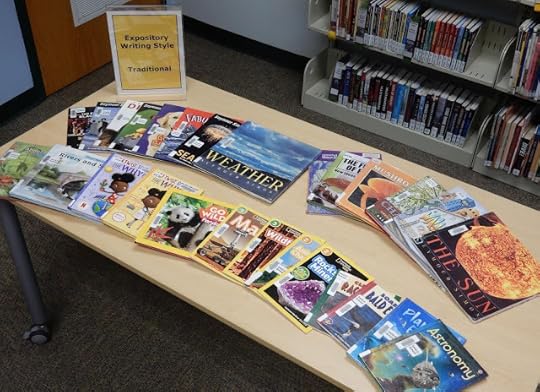
ExploringText Structures
To prepare students for theirinvestigation of nonfiction text structures, Ellen shared a guiding quotepulled from 5 Kinds of Nonfiction (page78).

We wanted students tounderstand that the way a writer structures their text can guide how theyresearch and take notes—and at the same time, the research and notes can help awriter decide which text structure might work best (Nonfiction Writers Dig Deep).
Next, students participatedin a modified version of Activity 6.2 in 5Kinds of Nonfiction. After looking at several different books about frogs,Ellen read aloud a short passage from one book and students worked with anelbow buddy to determine its text structure. Then, the class moved onto anotherbook.
To ease students into thisprocess, Ellen initially chose books with structures that are easier toidentify and worked up to trickier ones. Here is the order she used: Question& Answer, Sequence, Compare & Contrast, Description, List (3 examples),Cause & Effect, Problem & Solution. The two latter structures are themost challenging for students to identify.
Before: Books left to rightin alphabetical order by book title
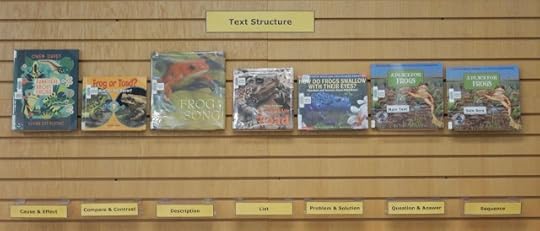
After: Books left to right inalphabetical order by text structure
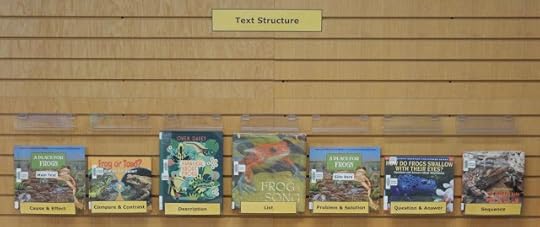
Finally, students participateda text structure scavenger hunt, rotating through seven sets of books (eachwith four titles) from 5 Kinds ofNonfiction (pages 79-82). Working with a partner and using the twoworksheets below, they read enough of each book to determine the text structurethat the four books in each set have in common.


After completing theactivity, students took some time to review the research notes they’d gathered sofar in Katie’s classroom and decided which text structure felt like the bestfit for the book they wanted to write.
IdentifyingCraft Moves in Expository Literature
During the next library lesson,student volunteers took turns reading aloud from slides (like the ones below) withbook passages highlighted in 5 Kinds ofNonfiction (pages 99-109). After viewing each slide, the fifth gradersturned and talked with an elbow buddy about any craft moves they noticed. Thenthe class worked together to identify voice, vivid verbs, repetition, rhyme,alliteration, assonance, onomatopoeia, sensory language, metaphors, and similesin the excerpts.


Next, each student selected abook from the expository literature or narrative book tables. After reading italoud with a classmate, the partners identified, discussed, and savored thecraft moves in the book.

Selecting Mentor Texts to Enrich Student Writing
During the final librarylesson, students spent time browsing among the five category book displays,which include all the nonfiction books they’ve interacted with over the lastfew weeks. The library is like a Fourth of July fireworks show—bright,exciting, and full of variety. Each book bursts with its own style andpersonality.
By the end of the period,each fifth grader headed back to the classroom with one or more mentor texts inhand, everything from traditional nonfiction for younger readers to top-notchexpository and narrative nonfiction picture books.
As an author, archaeologist,and fifth grade teacher, Katie McEnaney is always on a whirlwind huntfor the perfect artifact to illustrate a point and teach about the past. Herstories have been featured in LittleThoughts Press and the middle grade anthology Clio’s Curious Dash Through Time. When she’s not traveling theworld and geeking out over archaeological sites, you can find her at home inWisconsin with her husband, son, and two very-demanding cats. You can read herand her students’ book reviews at https://www.thelogonauts.com/.
As a school librarian, EllenBunn enjoys engaging K-8 students in research. She was a committee memberfor the Charlotte Zolotow Book Award (2016, 2017), Sibert Medal Award (2022),and South Asian Book Award (starting 2025). Previously she excavated andpublished about ancient hominin archaeological sites and hunter-gatherers ineastern and southern Africa, before teaching elementary science. Sheparticipates in rural land-use planning in Wisconsin, where she and her husbandhave raised three children, farm animals, and organic vegetables.
Socialmedia links for Katie:
https://www.instagram.com/katie_mcenaney
https://bsky.app/profile/katiemcenaney.bsky.social
Socialmedia links for Ellen:
https://bsky.app/profile/ellenbunn3.bsky.social
https://www.instagram.com/ellenbunn3
September 23, 2025
Writing Nonfiction Picture Books in Fifth Grade, Part 2: Investigating Mentor Texts in the Library for Book Category and Writing Style by Ellen Bunn and Katie McEnane
 Last Janury, fifth grade teacher Katie McEnaney (right) and school librarianEllen Bunn (left) wrote a
postdescribing a collaborative nonfiction writing unit
they’ve offered for several years at their school. Their article was verypopular, so now they’re back with a more detailed explanation.
Last Janury, fifth grade teacher Katie McEnaney (right) and school librarianEllen Bunn (left) wrote a
postdescribing a collaborative nonfiction writing unit
they’ve offered for several years at their school. Their article was verypopular, so now they’re back with a more detailed explanation.Over the next 3 weeks, they’llprovide a step-by-step breakdown of activities that took place in the libraryand discuss how those activities supported and enhanced the multi-week learningexperience.
Thank you, Katie and Ellen,for providing this additional information.

While fifth graders in Katie’s ELAclass researched and wrote nonfiction picture books to share with their secondgrade reading buddies, they also spent time in the school library where Ellenset up engaging hands-on activities adapted from 5 Kinds of Nonfiction (Stewart & Correia, 2021) and Nonfiction Writers Dig Deep (Stewart,2020). The goal was to find and explore mentor texts that highlight writingstyle (expository or narrative), clear text structure, vivid verbs and precise vocabulary,literary devices, and eye-catching design.
Inspirationfrom Nonfiction Authors
First, Ellen shared a slidedeck of inspiring quotes and images from diverse writers featured in Nonfiction Writers Dig Deep to engageand energize students in choosing a topic for their nonfiction picture book.

Reviewingand Sorting Books by Category and Writing Style
Next, the class exploreddifferent categories of nonfiction (active, browsable, traditional, expositoryliterature, and narrative) using an activity adapted from Activities 4.1 and4.2 in 5 Kinds of Nonfiction, Introducing the 5 Kinds of NonfictionActivity and Reinforcing the 5 Kinds of NonfictionActivity.

Student pairs moved at theirown pace among thematic text sets of five books each, including activism,birds, dinosaurs, dogs, and fashion from Sample 5 Kinds of Nonfiction TextSets as well as seven additional sets (shown at the end of thisarticle) created by Ellen. Students read enough of each book to recognize andrecord its category and writing style in the worksheet below. Some studentpairs became involved in one thematic text set, while others worked through twoor three text sets. And that’s okay!

Whole-classReflection and Conversation
In a follow-up class conversation,students reflected on the various nonfiction categories and writing styles and discussedwhich one(s) they might like to use when crafting their own nonfiction books.
OfferingAdditional Practice
After the library period, welooked over each pair’s written work and decided who needed more practicesorting books in a subsequent library session before moving onto the next stepof the process.
ADDITIONALTEXT SETS
*Titlesrecommended in Stewart & Correia 2021, the Celebrate Nonfiction blog, and/or the Celebrate Science website.
Coding and Technology

1.Active: *Szymanski, Jennifer. CodeThis!: Puzzles, Games, Challenges, and Computer Coding Concepts for the ProblemSolver in You. National Geographic Kids, 2019.
2.Browsable: Kelly, James. DKFindout!: Coding. DK, 2017.
3.Traditional: Daigneau, Jean. Code Cracking for Kids: SecretCommunications throughout History, with 21 Codes and Ciphers. ChicagoReview Press, 2020.
4.Expository Literature: Emberley, Michael. The Message: The Extraordinary Journey of anOrdinary Text Message. Atheneum, 2021.
5.Narrative: *Wallmark, Laurie. AdaByron Lovelace and the Thinking Machine. Creston Books, 2015.
Food
1. Active: *Cook,Deanna F. Cooking Class: Global Feast! 44Recipes that Celebrate the World’s Cultures. Storey Publishing, 2019.
2.Browsable: Claybourne, Anna. Don’tRead This Book Before Dinner. National Geographic Kids, 2019.
3.Traditional: Allman, Tony. TheFuture of Food: New Ideas about Eating. ReferencePoint Press, 2021.
4.Expository Literature: *Pizzoli, Greg. Pizza!: A Slice of History. Viking,2022.
5.Narrative: Frankel, Erin. APlate of Hope: The Inspiring Story of Chef José Andrés and World CentralKitchen. Random House Studio, 2024.
Fungi
1. Active: Gabriel,Alisha. Funky Fungi: 30 Activities forExploring Molds, Mushrooms, Lichens, and More. Chicago Review Press, 2022.
2.Browsable: Boddy, Lyne. HumongousFungus: The Weird and Wonderful Kingdom of Fungi. Underground All Aroundseries. DK, 2021.
3.Traditional: Johnson, Sylvia A. Mushrooms.Minneapolis, MN: Lerner, 1982.
4.Expository Literature: *Gianferrari, Maria. Fungi Grow. Beach Lane Books, 2023.
5.Narrative: Metcalf, Lindsay H. BeatrixPotter, Scientist. Albert Whitman, 2020.
Painting
1. Active: Coffee,Stephanie. Paint Lab for Kids: 52 adventures in painting and mixed mediafor budding artists of all ages. Quarry, 2016.
2.Browsable: Alexander, Heather. AChild’s Introduction to Painting: The World’s Greatest Paintings and Sculptures.Workman Kids, 2014.
3.Traditional: Fraser, Mary Ann. Wallto Wall: Mural Art around the World. Getty Publications, 2024.
4.Expository Literature: *Salyer, Hannah. Ancestory: The Mystery and Majesty ofAncient Cave Art. Clarion Books, 2023.
5.Narrative: Levinson, Cynthia. ThePeople's Painter :How Ben Shahn Fought for Justice with Art. Abrams, 2021.
Stars and Astronomy
1. Active:Aderin-Pocock, Maggie. Star Finder!: AStep-by-Step Guide to the Night Sky. New York, NY: DK Publishing, 2017.
2.Browsable: Stowell, Louie and Peter Allen. The Story of Astronomy and Space. Usborne, 2015.
3.Traditional: Simon, Seymour.Stars. Smithsonian, 2006.
4.Expository Literature: Chin, Jason. Your Place in the Universe. Neal Porter Books, 2020.
5.Narrative: *Larson, Kirsten W. TheFire of Stars: The Life and Brilliance of the Woman Who Discovered What StarsAre Made Of. Chronicle Books, 2023.
Trees
1. Active: Daniels,Patricia. Trees. National GeographicKids, 2017.
2.Browsable: Hickey, Cat. DK Findout!Forest. DK, 2017.
3.Traditional: Walker, Sally M. Champion:The Comeback Tale of the American Chestnut Tree. Henry Holt, 2018.
4.Expository Literature: Pendreigh, Kirsten. When a Tree Falls: Nurse Logs and Their Incredible Forest Power. Chronicle Books,2025.
5.Narrative: Napoli, Donna Jo. MamaMiti: Wangari Maathai and the Trees of Kenya. Simon & Schuster, 2010.
Weather
1. Active: Marder,Jenny. The Ultimate Kid’s Guide toWeather. Grosset & Dunlap, 2024.
2.Browsable: Drimmer, Stephanie Warren. Ultimate Weatherpedia: The Most Complete Weather Reference Ever. National Geographic Kids, 2019.
3.Traditional: Simon, Seymour. Weather.Morrow Junior Books, 2006.
4.Expository Literature: Singer, Marilyn. On the Same Day in March: A Tour of theWorld’s Weather. HarperCollins, 2000.
5.Narrative: Nickel, Sandra. Breakingthrough the Clouds: The Sometimes Turbulent Life of Meteorologist JoanneSimpson. Abrams, 2022.
Next week, we’ll share librarylessons in which students explored text structures and craft moves innonfiction picture books.
As an author, archaeologist,and fifth grade teacher, Katie McEnaney is always on a whirlwind huntfor the perfect artifact to illustrate a point and teach about the past. Herstories have been featured in LittleThoughts Press and the middle grade anthology Clio’s Curious Dash Through Time. When she’s not traveling theworld and geeking out over archaeological sites, you can find her at home inWisconsin with her husband, son, and two very-demanding cats. You can read herand her students’ book reviews at https://www.thelogonauts.com/ .
As a school librarian, EllenBunn enjoys engaging K-8 students in research. She was a committee memberfor the Charlotte Zolotow Book Award (2016, 2017), Sibert Medal Award (2022),and South Asian Book Award (starting 2025). Previously she excavated andpublished about ancient hominin archaeological sites and hunter-gatherers ineastern and southern Africa, before teaching elementary science. Sheparticipates in rural land-use planning in Wisconsin, where she and her husbandhave raised three children, farm animals, and organic vegetables.
Socialmedia links for Katie:
https://www.instagram.com/katie_mcenaney
https://bsky.app/profile/katiemcenaney.bsky.social
Socialmedia links for Ellen:
https://bsky.app/profile/ellenbunn3.bsky.social
https://www.instagram.com/ellenbunn3
September 16, 2025
Honoring Two Nonfiction Masters

At the end of 2022, my two most important nonfiction mentors passed away just a monthapart, and shortly after that, my mother died too. Some days my grief for allthree losses gets wrapped together. Though in different ways, they were all incrediblyimportant forces in my life, and I miss them so much.
Buttoday, in this blog post, I’m celebrating because Beach Lane Books is honoringthe memory of April and Steve by bringing four of the classic titles theyco-created back into print!
Nowa whole new generation of young readers can savor their amazing books.
Educatorsand librarians, editors and agents, writers and illustrators who have onlyrecently come to appreciate nonfiction literature for young readers can explorethe work of two innovative creators who helped transform a genre during their ground-breakingcareers.
Andthose of who had an opportunity to know and work alongside April and Steve canremember these nonfiction masters and experience the joy of re-visiting theirwords and art.







